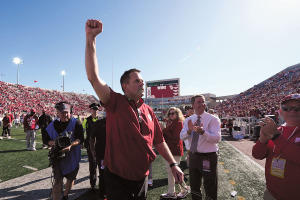Subscriber Benefit
As a subscriber you can listen to articles at work, in the car, or while you work out. Subscribe Now Former NFL coach Bum Phillips had an even better way with words than he did with winning. Once asked about the Miami Dolphins’ legendary mentor, Don Shula, he said, “He can take his’n and beat your’n and take your’n and beat his’n.”
Former NFL coach Bum Phillips had an even better way with words than he did with winning. Once asked about the Miami Dolphins’ legendary mentor, Don Shula, he said, “He can take his’n and beat your’n and take your’n and beat his’n.”
That’s as good a way as any to summarize the elite coaches of all sports, the ones who prove there’s more to winning than a talented roster. Sure, no coach wins anything of substance without adequate players; that’s always the first building block. But it’s also true that some coaches are much better than others at X-ing and O-ing, not to mention administrating and motivating.
The latest and most blatant example of that is Curt Cignetti, who has executed such an immediate and dramatic U-turn in Bloomington that fans of Indiana University’s downtrodden football program that has lost more games than any in division history are no more surprised and exhilarated than if they had won Powerball.
Cignetti’s Hoosiers are 10-0, ranked fifth—fifth!—in the nation and nearly a lock for a berth in the national playoffs, just one season after Tom Allen’s team finished 3-9. Should the Hoosiers win at second-ranked Ohio State on Nov. 23, they will merely need to defeat a Purdue team that has yet to win a conference game to finish undefeated.
That thought would have been filed under “football fiction” in the preseason. If you had placed a bet on it, you could retire on the payoff.
Building a winning program from the depths of despair is impressive enough, but to microwave one as Cignetti is doing is the rarest coaching feat. Granted, he’s had the good fortune of inheriting a velvety schedule and has benefited from the transfer portal. He brought 13 players with him from James Madison, where he coached the previous five seasons, and 10 of them started in last Saturday’s victory over Michigan. He brought in several other transfers as well, including the starting quarterback.
Still, winning right away, whether it’s with a thrown-together collection of players who require name tags in training camp or the team the previous coach left behind, reflects elite coaching acumen.
The standard procedure for new coaches is to be allowed a grace period of a few years to build the program in their image. Only a select few can override the standard break-in period. Shula, for example, brought immediate relief to the Miami Dolphins in 1970 by leading them to a 10-4 record one year after they had finished 3-10-1. No wonder Phillips was impressed.
Closer to home, only a precious few coaches of the “major” sports teams have pulled off something akin to what Cignetti is doing. Purdue football coach Joe Tiller did it. So did Pacers coach Bobby “Slick” Leonard. And maybe a Colts coach.
Examine them and something resembling a formula emerges.
Joe Tiller
Tiller took over at Purdue for the 1997 season, a year after Jim Colletto had gone 3-8 in his sixth consecutive losing season. With no transfer portal to accelerate the rebuilding process, with essentially the same group of underclassmen Colletto left behind, Tiller finished 9-3. He stated in his introductory press conference that he planned to win immediately and then backed it up—a more humble precursor to Cignetti’s “I-win-Google-me” declaration. Tiller’s innovative pass-oriented offensive system, which he dubbed “basketball on grass,” was a major component of his success, but there was more to it than that.
Edwin Watson, a senior running back on Tiller’s first team, experienced the transformation.
“It was a culture thing,” said Watson, a Zionsville resident who owns Triple E Realty and Property Management. “He established a culture of no excuses. He came in with an attitude of, ‘We’re going to win right now.’ It was an attitude and an expectation.”
Purdue lost at Toledo in Tiller’s debut, which didn’t exactly make for a good first impression, but came back the following week to stun Notre Dame. That sparked a six-game winning streak in a season that ended with a victory over Oklahoma State in the Alamo Bowl.
The response to the loss at Toledo was the season’s turning point and the boldest reflection of Tiller’s approach.
“We go to Toledo and lay an egg,” Watson said. “The norm before was that heads were hung low, we were getting screamed at, there was finger-pointing … but it wasn’t that. We did some things wrong and corrected them and moved forward.”
Tiller had a sharp sense of humor but was hard-nosed when necessary. He suspended a star player, Chike Okeafor, for being late to practice. Okeafor had to earn his way back onto the team and wound up playing in 10 NFL seasons. In other words, he directed a democracy, treating everyone the same.
“He made everybody always feel you were competing for your job,” Watson said. “That was new. I started as a freshman late in the season; by my senior year, I come in patting my chest thinking I’m the guy. Tiller came in saying, ‘No, you’re not. You’re going to have to earn some time.’ It was an awakening for us. You had to check your ego.”
Slick Leonard
The most dramatic about-face for the Pacers occurred early in the 1968-1969 season, when Leonard took over after nine games. The roster was loaded with four players who had appeared in the ABA’s all-star game the previous season, including two future Hall of Famers—Mel Daniels and Roger Brown—but they started just 1-7.
Five of the losses were by four points or less, and missed free throws were a factor. But something wasn’t right. Coach Larry Staverman, admittedly too nice for his own good, was fired the morning of the ninth game. (He coached it, anyway, and won.)
Leonard took over and, after a wobbly start due in part to his first six games coming on the road, turned it around. The Pacers finished that season 44-34 and reached the final round of the playoffs, a prelude to winning the league championship three of the next four seasons.
Leonard also was both hard-nosed and positive. Within his first six weeks as coach, he threatened Bob Netolicky with a hockey stick during a halftime locker room session and left Brown home on a two-game road trip, each instance a means of establishing a high standard for effort. His locker room tirades could peel paint off a wall, but he had a soft touch, as well. “You have to know when to kick them in the behind and when to throw an arm around them,” he often said.
Guard Jerry Harkness, a team captain that season before he was forced into retirement by injuries, summarized the difference between the two coaches: “Staverman was the kind of coach you wanted to win for, but Slick was the kind of coach you did win for.”
Ron Meyer
The Colts’ most dramatic turnaround since moving to Indianapolis came late in the 1986 season. Rod Dowhower, a strategist who lacked natural leadership qualities, was fired after his team fell to 0-13. Ron Meyer stepped in and won the last three games by bringing positive energy to the mix. His next team finished 9-6 and made the playoffs, but he failed to advance beyond that. He was fired during the 1991 season.
Meyer was regarded as a bit of a con man, with more style than substance. His program at Southern Methodist University was one of the NCAA’s all-time outlaw programs in the early ’80s, as detailed in an ESPN documentary, “Pony Excess.” Acts like that eventually wear thin. Turns out a positive outlook isn’t enough. A breath of fresh air grows stale if not backed by daily discipline, integrity and the ability to manage talent.
Curt Cignetti
Which brings us back to Cignetti. He’s never had a losing season as a head coach, whether at Indiana University Pennsylvania, Elon, James Madison or IU. For those who think he’s winning now because of the transfer portal and NIL money—both major factors, sure—he proved he can win immediately without those assets at his previous stops.
His most dramatic jump-start before this season was at Elon, where, in 2017, he took a team that had finished 2-9 the previous season and guided it to an 8-4 record. Like Tiller, his team lost his debut game at Toledo. It then ran off eight straight victories. Like Tiller, he took “your’n” and won, anyway.

Fishers native Connor Christiansen was a senior on Cignetti’s first Elon team. He had been a quarterback for the previous coaching staff, but an injury had compromised his throwing arm. Cignetti called him in after two practices and suggested he move to defensive back, a position he hadn’t played since junior high school.
He wound up starting, leading the team in interceptions and serving as an informal assistant coach because he could tell teammates what to anticipate from opposing quarterbacks.
“It was the most fun I had in football,” said Christiansen, who works in residential real estate in Charlotte, North Carolina, and stays in touch with Cignetti.
“He knew I was struggling and couldn’t throw anymore and [that] it was getting me down. He said, ‘Hey, you can still play football.’ Even when I didn’t think I could do it, he believed in me.”
Instilling belief is the foundation of all the coaches who pull off quick fixes. Cignetti went to work on that the moment he was introduced to IU fans during halftime of a basketball game last winter, when he declared “Purdue sucks. But so does Michigan and Ohio State.” That sounded like someone begging for a backlash at the time, but now stands as a testament of faith—providing his team isn’t embarrassed next weekend at Ohio State.
“We went in [to the season] fully anticipating winning, which was pretty cool considering we had the same players [as before],” Christiansen said. “No big changes, no crazy transfers. Just the belief we could win. Nobody cared about stats, nobody cared who scored. It was, ‘Let’s go win and have a good time after and come back the next day.’
“He believes he’s the best, and he’s a great leader. It’s just the way his confidence and expectations wear off on you. ‘Fast, physical, relentless, no self-imposed limitations’ … he said those things to us every day. At some point, you start to believe it.”
At this point, Cignetti is amassing a nation of believers.•
__________
Montieth, an Indianapolis native, is a longtime newspaper reporter and freelance writer. He is the author of three books: “Passion Play: Coach Gene Keady and the Purdue Boilermakers,” “Reborn: The Pacers and the Return of Pro Basketball to Indianapolis,” and “Extra Innings: My Life in Baseball,” with former Indianapolis Indians President Max Schumacher.
Please enable JavaScript to view this content.

Great article, great year and so much fun for our fan base and alumni.
Cig has laid a new foundation for great success!
As a suffering Illini fan for the last 50 years I can only say . . . WTF? Go Hoosiers!